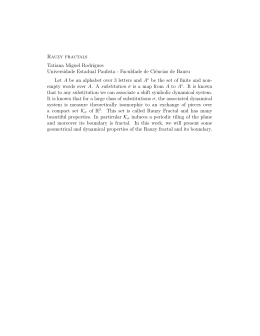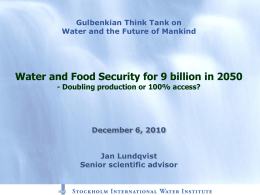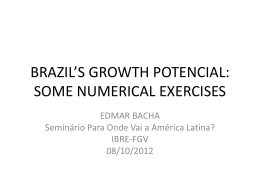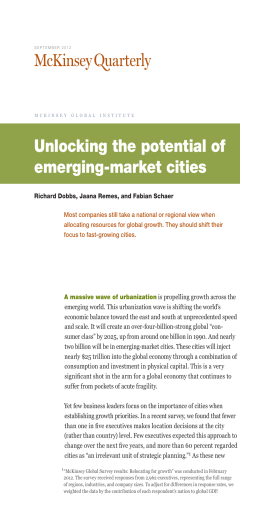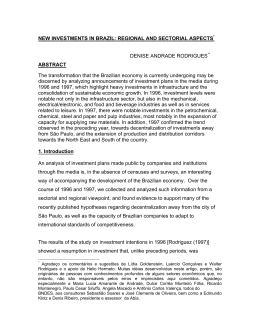Brazilian Journal of Political Economy, vol. 27, n° 1 (105), pp 3-19, January-March/2007 Why foreign savings fail to cause growth LUIZ CARLOS BRESSER-PEREIRA PAULO GALA* The present paper is a formalization of the critique of the growth with foreign savings strategy that one of its authors has been doing in recent years. Although medium income countries are capital poor, current account deficits (foreign savings), financed either by loans or by foreign direct investments, will not usually increase the rate of capital accumulation or will have little impact on it in so far as current account deficits will be associated with appreciated exchange rates, artificially increased real wages and salaries and high consumption levels. In consequence, the rate of substitution of foreign savings for domestic savings will be relatively high, and the country gets indebted not to invest and grow but to consume. Only when there are large investment opportunities, stimulated by a sizeable difference between the expected profit rate and the long term interest rate, the marginal propensity to consume will get down enough so that the additional income originated from foreign capital flows will be used for investment rather than for consumption. In this special case, the rate of substitution of foreign for domestic savings tend to be small and foreign savings will contribute positively to growth. Key-words: foreign savings, economic growth. JEL classification: E1, E2, F0, F3, O11. A reasonable assumption of all development theories is that, given a certain level of technical progress and the way available resources are allocated, the higher the savings and investment rates, the higher the economic growth. On the other hand, since the appearance of the development economics, in the 40's and the 50's, with the classical studies of Rosenstein-Rodan, Nurkse, Lewis, a second assumption was that, given the developing countries' shortage of savings, besides adopting mechanisms of * Escola de Economia de São Paulo da Fundação Getúlio Vargas. E-mail: [email protected] e [email protected]. Submitted: June 2005; Accepted: September 2005. 3 forced domestic savings by increasing public savings, foreign savings in the form of credit facilities and investments would be the way par excellence of promoting such a development. For some very backward countries, with very low capital accumulation rates, this was an obvious alternative. It also seemed reasonable to be applied to middle income countries. Between the 30's and the 60's, however, this proposition was not put into practice since the amount of savings transferred by rich countries to the most developed countries was small. In the 50's, direct external investments in the industry of developing countries became a reality, and in the 70's it was finally possible for many countries to incur in high current account deficits, and finance them by increasing financial or equity debt. The episode ended with the major foreign debt crisis of the 80's. In the 90's, after the Brady Plan settled the former crisis, the idea was taken up again and became a ‘growth strategy’ offered to developing countries: the ‘growth with foreign savings and opening of the capital account strategy’. Two assumptions were behind this proposition: first, ‘it is natural for capital-rich countries to transfer their capital to capital-poor countries’, and, second, foreign savings received by a country will automatically be transformed into productive investment. According to the conventional argument, the opening of the capital account, which then became highly recommended, would contribute to increase a country's per capita income, since it would expand productive investment options of its local agents. A country with low per capita income and, therefore, with a low stock of capital, would present a higher marginal productivity of capital as compared to a developed country. The higher return on investment would allow the poorer country to increase its productive capacity, later paying to the richer country the interests and the total amount of the incurred debt with the results of the productive investment of borrowed resources. For the developed country, the possibility of investing savings at a higher rate than the domestic remuneration would also bring welfare gains. The opening of the capital account would enable a process of arbitration which, theoretically, would be able to equate marginal products of capital in different economies, increasing the well-being of poor and rich countries in a possible optimum arrangement. The conclusion of this argument on marginal productivities of capital and market arbitration is that developing countries should necessarily live with current account deficits, because only then would they profit from foreign savings. In the words of Obstfeld & Rogoff: “economic policy makers often express concern about national current account deficits or surpluses. Our simple model makes the very important point that an unbalanced current account is not necessarily a bad thing. […] intertemporal trade makes possible a less jagged time profile of consumption [or investment]” (Obstfeld and Rogoff 1996, pg.18). As a result, a relatively appreciated level 4 of real exchange rate and permanent current account deficits would be normal and advisable conditions for developing countries provided they were moderate, not leading to balance of payment crises. Our criticism goes directly against this argument. In previous studies we criticized this policy and the resulting exchange rate overvaluation, showing that the outcome of foreign savings inflow is not mainly the increase in the investment rate but the increase in consumption and foreign indebtedness, but we had not formalized this reasoning. In several cases we studied, we observed that there was a strong, although variable, process of substitution of foreign for domestic savings. It was only in the case of countries that went through moments of very fast growth, followed or caused by large investment opportunities that this rate, which we propose to call the ‘rate of substitution of foreign for domestic savings’, was small, and foreign savings really contributed to the country's development.1 The purpose of this paper is to formalize this argument and to criticize the growth with foreign savings strategy currently advocated in economic theory, or, more broadly, to criticize the assumption that ‘capital-rich countries should transfer their resources to capital-poor countries’; it is also to criticize the models of development economics that examined the ‘external constraint’ and proposed to circumvent it through foreign financing of investments. 2 It is to demonstrate that a high rate of substitution of foreign for domestic savings causes foreign indebtedness and implies the obligation of remunerating it without a corresponding increase in the country's productive capacity. The abuse of foreign savings doesn't need to be criticized, since its outcome is excessive foreign indebtedness and balance-of-payment crisis.3 Before this point that sets the problem's limit, we have the financial weakening of and the increased dependency the developing economies that chronically resort to current account deficits, which also do not require a sophisticated critique. Except in the case of high investment opportunities, the growth with foreign savings strategy is harmful to the country, even when current account deficits do not cause a balance-of-payment crisis or financial weakening and dependency, because a substantial part of the foreign financing, whether as loan or as direct investment, tends to go into consumption. 1 See Bresser-Pereira (2001, 2002, 2004), Bresser-Pereira and Nakano (2003), and Bresser-Pereira and Varela (2004). 2 See Hollis Chenery and Michael Bruno (1962), “Development alternatives in an open economy: the case of Israel”. It should be observed that our criticism is not directed to this particular paper, since Israel presented the necessary investments opportunities to make feasible the growth with foreign savings, but to the widespread idea resulting from the ‘dual gap model’ to justify foreign indebtedness. 3 A balance-of-payment crisis usually occurs when a country exceeds the foreign debt threshold, as the foreign debt/exports ratio rises and eventually generates a situation in which there is a growing concern among international creditors. (Cohen, 1994; Patillo, Poirson, and Ricci, 2002). 5 Although foreign indebtedness is an old problem, the idea of growth with foreign savings assumed its character of deliberate strategy and became dominant only in the 90's. It was then followed by the financial opening of developing countries and by the great increase in capital flows towards them. Yet, the extensive literature on the opening of the capital account does not discuss the growth with foreign savings strategy because it assumes that capital-rich countries should always transfer their capital to poor countries; it rather stresses problems related to the opening of the capital account, such as the high volatility of capital flows, or, simply, problems related to foreign indebtedness, such as the concept of ‘original sin’, i.e., the fact that those countries cannot, as rich countries do, borrow in their own currency.4 On the other hand, in the economic journalistic literature, foreign savings are usually confused with direct investments. It isn't clear that direct investments do not necessarily finance current account deficits that are foreign savings; they may even finance the increase in international reserves of the receiving country or direct investments made by this country abroad. 5 Regarding exchange rate management in this process, we assume that the ‘fix or float’ alternative is false, as is the assumption that, in the long run, the real exchange rate cannot be managed: in practice, countries, within certain limits, and within a reasonable span of time,6 manage their exchange rate. Actually, this management begins, in the model that we will present in this paper, with the very decision of adopting the growth with foreign savings strategy. When a country accepts this strategy, it is managing downwards (appreciating) the exchange rate, since the current account deficit implied by it results necessarily into a more appreciated exchange rate than the one that would exist in the absence of such a deficit and in the presence of current account equilibrium. On the opposite side, when a country grows with foreign ‘dis-savings’, that is, with current account surplus, it will be managing its exchange rate so as to keep it relatively depreciated. It is true that often countries that accept the growth with foreign savings strategy do not realize that it implies an appreciated exchange rate, but this lack of consciousness does not change the fact that they are managing downwards their exchange rates by accepting capital flows without restrictions.7 4 Among this vast literature, we mention here only Calvo, Leiderman and Reinhart Eichengreen and Leblang (1995), Rodrik (1998), Eichengreen and Leblang (2002), Eichengreen (2003). 5 This is the case of Asian dynamic countries that grow with current account surpluses: direct investments entering the country are compensated by direct investments that this country's companies make abroad or by an increase in their international reserves. 6 The idea that the real exchange rate cannot be managed in the long run is only true if the time implicit in this ‘long run’ is very large – more than 20 years –, but in this case the restriction becomes irrelevant. What matters is the management of the exchange rate in a reasonable amount of time, which would be relatively under the control of the economic policymaker. 7 There are others and more rational ways of managing the exchange rate and avoiding it to evaluate and lose competitiveness, but their discussion is out of the scope of this paper. 6 In the model we present here the exchange rate is central – it is the macroeconomic strategic price – and is determined by the country's decision of accepting the conventional orthodoxy's assumption that it needs foreign savings to grow. The exchange rate is a consequence of this decision and of the previous deregulation of the capital account. From then on, the exchange rate on the one hand determines exports and investments, that is, the aggregate demand, as well as real wages and resultant profits, that is, the distribution of income; on the other hand, it determines imports and savings, that is, the aggregate supply; finally, depending on the propensity to consume prevailing in the economy, it determines the rate of substitution of foreign for domestic savings. In the first section of this paper we will discuss some formalized relations of national accounts; in the second, we will show that there may be a higher or lower degree of substitution of foreign for domestic savings, depending on the existence of large investment opportunities. In the third section we will list previous empirical research demonstrating the existence of relatively high rates of substitution of foreign for domestic savings, or savings displacement. The last section presents a brief conclusion. SOME FORMAL RELATIONS We begin with the relations of national accounts of a economy with no government, in which the product Y is the sum of investment I, consumption C, and exports X, minus imports M; gross income Rb is the sum of workers' wages Wt , salaries of the professional middle class Wo , and profits Π ; and the national income Rn is the gross income minus the returns on capital sent abroad RLE . Investment is equal to savings S , investment determining savings on the side of the demand, savings financing investment ex-post. The income level is determined by expenses in consumption and investment Y =C+I + X −M (1) Rb = Wt + Wo + Π + RLE (2) I = S = Si + S x (3) Foreign savings, that is, savings that a country receives from abroad, are equal to the current account deficit, which, in turn, corresponds to the trade balance plus net returns sent abroad. S x = M − X + RLE [foreign savings] (3.1) Foreign savings, for its part, will vary with the real exchange rate (θ). The more it is appreciated, the smaller the exports and the bigger the imports, and, therefore, the bigger the current account deficit or foreign savings 7 Domestic savings are equal to returns on labor and capital minus consumption. S i = Wt + Wo + Π − C [domestic savings] (3.2) From (1) and (2), we have C + I + X − M = Wt + Wo + Π + RLE (4) therefore, we return to the identity (3) I = (Wt + Wo + Π − C ) + ( M − X + RLE ) [domestic savings S i + foreign savings S x ] (5) As a strategic macroeconomic price, the exchange rate does not fully determine foreign savings or current account deficit only because this deficit depends also on the amount of the net income sent abroad or received from abroad, as well as on the country's terms of trade (which are considered constant here). We will understand that the ‘equilibrium’ exchange rate or, more precisely, the ‘reference’ exchange rate is the one that assures intertemporal balancing of the current account.8 It varies around this point in view of capital inflows and outflows. If we assume international reserves as constant, the exchange rate will depend on the balance or deficit of the current account. It ensues from that a fundamental consequence for developing economies and for this model: when a country adopts the growth with foreign savings strategy, and finances the current account deficits whether with loans or with direct investments, the exchange rate will be appreciated as compared to the one that would prevail if the strategy were to keep a balanced current account.9 But the exchange rate has another less discussed consequence. The higher it is the higher real wages (of the workers) and salaries (of the professional middle class) will be because the price of internationally tradable consumer goods (commodities) decreases with the appreciation of the local currency. As a trade-off, capitalists' profits, Π , will drop, whether because, on the income side, wages and salaries have grown, or because, on the demand side, business firms will be exporting and investing less. Each economy will have a variation in wages and salaries in connection with the exchange rate φ , that will be higher for each household the higher the consumption of tradables and the higher the sensitivity of exports and imports to the exchange rate. In any case, this will be a relatively stable relation, which will 8 Reference exchange rate is a good expression because it avoids the discussion on which is the equilibrium exchange rate. 9 The existence of a current account deficit is associated with the relative exchange rate appreciation and, therefore, could involve a market pressure to depreciate it and to close the deficit. However, since we are talking here of a ‘strategy’, this means that economic authorities are satisfied with the deficit and, especially through a policy of high interest rates, try to keep the exchange rate in a relatively appreciated level, consistent with the deficit. 8 only be altered in the long run. Profits, wages, and salaries, therefore, besides substantially depending on the economy's productivity level and on its income distribution pattern, depend on the exchange rate. How does this relation occur? The profit rate is the inverse of the wage rate, as we can see below in equation (8). For the real exchange rate θ , we adopt the traditional definition of nominal exchange rate, e , multiplied by the ratio between foreign prices P * and domestic prices P , θ = eP * / P (6) Assuming that workers receive a nominal wage, w , and acquire tradables and non-tradables, we will have that workers' cost of living Q will depend on the nominal exchange rate and on the portion of tradables in their consumer basket α . Q = P (1−α ) eP *α (7) Assuming also that prices are formed in the economy according to the known Kaleckian rule that relates the price level P to nominal wage w , to the level of productivity b and to the mark up m , P = w(1 + m)1 / b (8) we are able to observe, from the definition of the real exchange rate (6), of workers' cost of living (7), and of price formation (8), that the real wage w / Q is a function of productivity, of the real exchange rate, and of the mark-up or income distribution pattern.10 w / Q = b /(1 + m)θ α (9) ∂w / Q / ∂θ = φ < 0 (9.1) From those definitions, we will have that a depreciation of the real exchange rate with the increase in the price of tradables in relation to the nominal wage will mean a decrease in real wage, since the worker's consumer basket will be more expensive. The fundamental restriction to a real depreciation is that a possible increase in nominal wages resulting from nominal depreciation shall not exceed the increase in e , given P * . This will only happen if the prices of non-tradables, especially nominal wages, remain constant or change less than proportionally to the exchange rate variation. We are, therefore, accepting the Keynesian assumption of nominal wage rigidity and real wage flexibility, instead of the neoclassical assumption of nominal wage flexibility and real wage rigidity.11 As for profits, we know that they depend on investments, which, in turn, besides depending on the expected profit rate given the interest rate, depend 10 11 Bhaduri and Marglin (1990), Simonsen and Cysne (1995: 452). Corden (1981: 31-32). 9 on exports. Profits decline, therefore, when the exchange rate appreciates and exports drop – the decrease in capitalists' profits being complementary to the increase in wages and salaries of workers and of the professional middle class. The coefficient that links profits to the exchange rate, that is, the elasticity of the profits in relation to the exchange rate will be λ . Consumption, for its part, depends on real wages and salaries and on profits, that is, on income, and on the differential between the interest rate, i and the profit rate, r . The marginal propensity to consume or the variation of consumption with regard to income from real wages and salaries is defined by μ . C = C ( w / Q, r , i ) (10) ∂C / ∂w / Q = μ ≥ 0 (10.1) Therefore, consumption varies in line with the variation of wages and salaries and the variation of profits, and varies negatively in relation to the differential between the expected profit rate and the interest rate. When the growth with foreign savings strategy prevails, and, thus, the policy of growing with current account deficits, the exchange rate will stay at a relatively appreciated level, which causes wages and salaries to rise (as compared to the position associated with the reference exchange rate) and the amount of wages and salaries to remain at an artificially high level – that is, incompatible with their productivity, or with the satisfactory profit rate that keeps the economy growing – whereas profits decline. Assuming that the effect of the first movement on consumption is higher than the effect of the second one, since the propensity to consume of workers and of the middle class is much higher than that of capitalists, consumption will increase and will stay high with the relative currency appreciation, reducing domestic savings. In this formalization, domestic savings, therefore, is a function of the exchange rate. It could be argued that the increase in workers' wages in middle income economies in which a high concentration of income prevails is not something negative, and that it will not necessarily reduce the profit rate in case of a shortage of demand. First, however, we must stress that wage increases resulting from a decrease in interests, rents, and speculative profits are always welcome; we don't believe, however, that an artificial increase in wages through the overvaluation of the exchange rate could be included among desirable wage increases. Second, we stress that we are reasoning, for the moment, in terms of the supply side, and, therefore, we are not presuming a shortage of demand. When we examine the impacts of overvaluation from the demand side, the Keynesian possibility of shortage of demand is fulfilled. Following this view, the decrease in exports will cause a decrease in investment opportunities or profit expectations, in investments themselves, and, 10 consequently, according to Kalecky, in profits and domestic savings. At the same time, from the supply side perspective, the increase in the wages and salaries caused by the exchange rate appreciation, by increasing consumption and decreasing the amount of profits, will lead to a decline in the investment financed by domestic savings. Both movements therefore ratify one another, and result in a reduction in investments. However, since there is an inflow of foreign savings, and of investments financed by them, total investment and the rate of investment may increase, remain constant, or decrease, depending on the rate of substitution of foreign for domestic savings, z. SUBSTITUTION OF FOREIGN FOR DOMESTIC SAVINGS We are now in a position to define the rate of substitution of foreign for domestic savings. According to the criticism developed here, although we work with variations of the exchange rate, we are more interested in its level. We are interested only secondarily in the moment of appreciation or depreciation of the exchange rate. More important to us is the level of the exchange rate and of the corresponding foreign savings. Let's assume two periods: t , where foreign savings are zero and the exchange rate is the reference exchange rate or the “equilibrium” exchange rate, and period t + 1 , in which there is a current account deficit (surplus), and the exchange rate is low (high) or appreciated (depreciated). The main question is the potential increase in the investment rate. From the supply side point of view, the key variable is the propensity to consume, responding to the variation of wages and salaries in one direction, and to the variation of profits, in another direction and to the differential between the interest rate, i and the profit rate, r . For a given change of the exchange rate, the variation of total consumption will be higher or lower, depending on the differential of the expected profit rate-interest rate r -i. From the demand side perspective, the key variable is the elasticity of exports to the variation of the exchange rate, ε, and the elasticity of the investment rate to exports, or, more directly, the response of investment to the exchange rate, ϕ . What will the response of domestic savings due to the appreciation of the currency of the country receiving foreign savings be? Or, in other words, on what will the rate of substitution of foreign for domestic savings, z depend? We have here a trade-off: an increase in the first one tends to entail a decrease in the second one. An appreciation of the local currency may bring domestic savings down to the same amount or even less than the amount represented by the increase in foreign savings, thus causing savings displacement. We are able to observe, from equation (5) that, if the decrease 11 in S i is higher than the increase in S x , total savings drop, total investment drops, total consumption increases, and income remains stable. Equation (11) defines that trade-off, that is, the rate of substitution of foreign for domestic savings, z . z = ∂S i / ∂S x (11) On what does z depend? This rate depends on the variation of wages and salaries in response to the exchange rate appreciation φ , on the variation of profits in relation to the exchange rate λ , – relations that may be considered reasonably stable – on the propensity to consume, and on the differential interest rate-profits, that is, on investment opportunities. If there are large investment opportunities, in addition to the fact that the capitalist class will use a larger portion of its expected and earned income to invest, increasing its marginal propensity to invest, the increases in working class wages and mostly in middle class salaries will also increase their marginal propensity to invest, possibly offsetting the incentives to increased consumption arising from increases in real wages. From the demand side perspective, z , or the rate of substitution of foreign for domestic savings, will be higher the higher the elasticity of exports to the variation of the exchange rate, and the higher the elasticity of investments to exports, and, thus, of the coefficient relating investments to the variation of the exchange rate, ϕ . Decreased domestic savings caused by the decrease in exports and investment caused by the exchange rate appreciation is sanctioned by the direct decrease in domestic savings caused by the increase in real wages and by the increased consumption caused by the same exchange rate appreciation. What is, in practice, the meaning of the rate of substitution of foreign for domestic savings? Ignoring the sign, if z is equal to 1 or to 100%, this means that the increase in foreign savings corresponded to a decrease of equal amount in domestic savings, so that there was a complete substitution; if z is 0 , there was no substitution of savings. In the first case, foreign savings didn't cause any increase in the rate of investment; in the second one, all of it was transformed into an increase in investment and, therefore, in the rate of investment. In the intermediate cases, part of the foreign savings will be canalized to consumption and part to investment. The rate of substitution of foreign for domestic savings will be higher mainly if the differential between the expected rate of profit and the interest rate is low, that is, investments opportunities are low. In this case, besides the fact that the workers show a high propensity to consume, the middle class will also tend to consume nearly all the increase in its salaries, and not even the capitalists who face falling profits will significantly reduce their consumption. If the differential r is small, therefore, we will have “normal” investment opportunities, which will not stimulate the middle class to 12 transfer part of its salary increase to investment, nor convince capitalists to consume less. Consequently, the inflow of foreign savings will be strongly compensated by decreased domestic savings resulting from increased consumption. Besides, profits themselves and their reinvestment will be modest. The outcome of both facts is that there will be no new investments, in spite of the inflow of foreign savings. On the other hand, if the differential of profit rate-interests is high and the variation μ is low, a big part of the increase in wages and salaries will be directed not to consumption, but to investment. In this paper, our main hypothesis is that, in a normal situation, the rate of substitution of foreign for domestic savings tends to be high, approaching − 1 when current account deficits occur without an actual connection with investments and a growth process, as we saw in Latin America in the 90's. However, historically or empirically, we know that, in certain circumstances, countries developed with foreign savings. What is the condition for this to occur, that is, for the substitution of foreign for domestic savings to remain close to 0 ? For the value of z to remain closer to 0 than to 100%, it will be necessary that a favorable combination of externalities and increased demand give rise to a situation of large investment opportunities, which are expressed by high expected profit rates, always combined with high GDP growth rates. It is important to remark that, in much the same way as there is a substitution of foreign for domestic savings when the current account deficit increases, the opposite may happen; the substitution of domestic for foreign savings when the current account deficit or foreign savings are diminishing. In this case, from the supply side point of view, wages and salaries will fall; from the demand side point of view, exports and investments will rise, causing the reverse substitution. EMPIRICAL EVIDENCE There is today a substantial empirical literature dealing with the relationship between domestic and foreign savings. Several studies try to measure the sensitivity of domestic savings to the use of foreign savings in developing countries. The central focus of the studies is empirical, and the attention is generally drawn to the possible determinants of domestic savings. Most studies point to the result of the substitution of foreign for domestic savings, in what seems to be almost a consensus in the literature. Curiously enough, the exchange rate issue is set aside. Most studies in that literature are not concerned with the role of the exchange rate in determining the level of domestic or foreign savings, nor present an explanatory theory on the rate of substitution of domestic for foreign savings. They limit 13 themselves to present the results of their research, which are significant, without offering an explanatory theory. Before the classic research of Feldstein and Horioka (1980) regarding rich OCDE countries,12 Fry (1978) was one of the pioneers in econometric studies with the intent to measure the possible determinants of domestic savings. Although he was not primarily concerned with the relationship between domestic and foreign savings, he provides interesting results on the degree of substitution between the two, in his empirical analyses. He formulates the following econometric specification: Sd / Y = f ( g , y, r , Sf / Y , Sd / Y−1 ) Sd / Y : domestic savings / GDP, g : GDP growth rate, y : natural log of per capita GDP measured in dollars of 1970, r : real interest rate, Sf / Y : foreign savings / GDP. The results are obtained with regressions with dummies for the different countries. The data include 7 Asian countries in the 1962-1972 period: India (1962-1972), South Korea (1962-1972), Myanmar (1962-1969), Malaysia (1963-1972), Philippines (1962-1972), Singapore (1965-1972), and Taiwan (1962-1972). The results point to a value of about -0.5 for the substitution of foreign for domestic savings in the several types of specification of the model. That is to say, 50% of the use of foreign savings would be neutralized by a decrease in domestic savings. The degree of substitution is considerable for this sample of countries in the said period. Edwards (1995) performs an extensive analysis on the determinants of private domestic savings. Besides discussing a few theoretical aspects concerning several explanations for different levels of domestic savings, he presents an extensive empirical analysis for developed and developing countries. He makes estimations with using panel data from 1970 to 1992 for 25 developing countries and 11 developed countries. He uses as independent variables and, therefore, as possible candidates in the determination of the private domestic savings rate, an extensive list: demographic dependency rate (population younger than 15 years old + population over 65 years old divided by population between 15 and 65 years old), urban population, government savings, growth rates, GDP per capita, money supply/GDP, credit to the private sector, public expenditure on social security and welfare, real interest rate, foreign savings, inflation, income distribution, political stability. In the different estimated models he finds once again a negative value around 0.5 for the coefficient of foreign savings (minimum 0.38, 12 A great number of further researches confirmed the findings of Feldstein and Horioka. Surprised economists, however, insisted on talking about the ‘Feldstein-Horioka puzzle’. In the last few years, however, econometric studies showed that their results were essentially a country solvency constraint (Sinn, 1992; Rocha and Zerbini, 2002; Coakley, Kulasi, and Smith, 2002). 14 maximum 0.625), showing a substantial substitution between private domestic savings and foreign savings. Schmidt-Hebel et al. study the behavior of domestic savings from a household perspective. Instead of focusing on aggregate savings, they base their empirical analysis on household savings in relation to available income. Among the independent variables used for estimation, they select: household per capita income in levels (rates and trend) real interest rates, rates of inflation, foreign savings, among others. Calculations are made for 10 developing economies between 1970 and 1985 with panel data, using a model of fixed and random effects. The coefficients related to foreign savings point to values around -0.2, showing some degree of substitution between foreign savings and domestic savings. The authors call the attention to this fact: “foreign saving, which acts as an external liquidity constraint, boosts private consumption, as shown by its significantly negative influence on saving”13. Reinhart and Talvi (1998) make a comparison between Asia and Latin America regarding the substitution between foreign savings and domestic savings. They argue that the high levels of savings in Asia are more related to historical trends than to the behavior of capital flows. They find empirical results that are in line with those of Schmidt-Hebbel (1992) and Edwards (1995), in the sense that there is a reasonable degree of substitution between the two. The use of foreign savings correlates negatively with the level of domestic savings for both regions. Using a specification close to Fry's (1978), where domestic savings are defined as a function of foreign savings and as a vector of other determinants, Uthoff and Titelman (1998) equally find a substitution of foreign for domestic savings around -0.5. The authors formulate the following econometric specification: S / Y = α 0 + α 1Ytk + α 2 DYTtk + α 3 CREC tk + α 4 INFLtk + α 5 RDDtk + α 6 FSTtk + α 7 DFSTtk + α 8 IRtk + ε tk : country k in the period t, S / Y : domestic savings, YT : GDP per capita trend, DYT : trend deviations of GDP per capita, CREC : GDP per capita growth rate, INFL : inflation rate, RDD : demographic dependency rate, FST : foreign savings trend, DFST : trend deviation of foreign savings, IR : real interest rate. The estimates encompass 15 Latin American and Caribbean countries between 1972 and 1993, using cross-section data and time series, totalling 330 observations. The estimations used the methods of fixed and random effects with and without instruments. The results regarding foreign savings 13 Schmidt-Hebel et al., 1992: 543 15 indicate a highly significant negative coefficient of -0.47. The authors also estimate the impact of foreign savings on domestic savings, from a separation between trend and trend deviation of foreign savings. Once again the results indicate a substitution of foreign for domestic savings around 0.48, with values between -0.31 and -0.46 for the impact of the increased trend, and between –0.48 and –0.49 for trend deviations. The authors call the attention to the Mexican case. From 1983-90 to 1992-94, the use of foreign savings in Mexico grew 7.4 percentage points of GDP, but the investment rate grew only 4.4 percentage points of GDP. A large amount of the foreign resources was used to finance increased consumption, and domestic savings declined. For the average of Latin America, foreign savings increased 2 percentage points between 1983-90 and 1992-1994, whereas the investment rate increased 0.3% percentage points of GDP, and domestic savings dropped 1.7 percentage points14. Although they do not use directly the exchange rate in the econometric measurements, those studies supply empirical evidence favorable, however indirectly, to the theoretical arguments presented in this paper. Assuming that situations of current account deficit are accompanied by some degree of exchange rate appreciation, we may conclude that the empirical studies presented above are in line with the argument that, in general, the use of foreign savings is connected to the decrease in domestic savings and to the increase in the aggregate level of consumption. On the other hand, the variation observed in the substitution of foreign for domestic savings, depending on the country and the moment the data are collected, probably derives from the existence or not, in each studied moment, of very high profit rate expectations, or, in other words, of large investment opportunities derived from high growth rates. In the already mentioned original studies of Bresser-Pereira, individually or with Y. Nakano, or with C. Varela, that criticized the growth with foreign savings strategy, this formalization didn't exist, but several other empirical confirmations were already present, especially those related to the 90's in Brazil and in Latin America. Using the methodology developed here, Bresser-Pereira (2006) estimated the rate of substitution of foreign for domestic savings in Brazil between 1994 and 1999, when the country's current account deficit increased strongly and found a substitution rate of 72.4%; on the other hand, he estimated the rate of substitution of domestic for foreign savings between 2000 and 2005, when the reverse movement of the current account deficit took place and found a rate of substitution of domestic for foreign savings of 114%.15 This happened because the increase 14 Uthoff and Titelman, 1998:36 The variations were calculated on the basis of the average of the variables in the three years before each of the two periods. 15 16 in foreign savings during the first period did not imply any increase, but rather a small decrease in the investment rate, whereas, during the following period, the structural shock caused by the exchange rate depreciation and the increase in the prices of goods exported from Brazil, transforming foreign savings in dis-savings, didn't cause any decrease, but rather a small increase in the investment rate.16 CONCLUSION This paper shows what happens when an economy decides to ‘grow with foreign savings’ which implies an appreciation of the exchange rate as compared to the reference exchange rate bringing the country's current account to an intertemporal balance. In the formalization of the critique of the growth with foreign savings strategy which we have just presented, the exchange rate defines, from the supply side perspective, not only exports X and imports M and, therefore, foreign savings, but also real wages and salaries and profits and, therefore, consumption and domestic savings. Given the assumption of a stable relation between exchange rate and wages, salaries, and profits, the fundamental variable in this case is the response of consumption to variations in the real exchange rate, which will vary depending on the existence of normal or large investment opportunities. From the demand side perspective, investment and, therefore, savings depend on the elasticity of exports to the exchange rate, and of investments to exports, or, more directly, of investments to the exchange rate, ϕ . Therefore, the exchange rate level defines also the investment. Capital inflows or more precisely foreign savings tend to produce exchange rate appreciation, increase in real wages and imports, since the variation of consumption in relation to the remuneration of workers and the middle class is generally higher than zero (µ > 0). It also tends, from the demand side perspective, to reduce exports, investments, and domestic savings. As a consequence, we have a significant substitution of foreign for domestic savings, which we may presume to be, in normal circumstances, around 50%, but which may vary upwards or downwards depending on the economic situation. This means, for instance, that a direct investment yielding 20% of return for its owner may result, for the country, in an annual payment of 40% of the actual investment which was in net terms half of the country received (the other half was consumed). When, however, there are 16 The positive structural shock suffered by Brazilian economy changed the current account deficit of 4.73% of the GDP in 1999 into a surplus of 1.65% in 2005, corresponding to an external adjustment of 6.38% of the GDP. However, the average rate of investment between 1997 and 1999, which was 15.09%, reached 18.11% of the GDP during the period 2000-2005. 17 high growth rates and the differential between the expected profit rate and the long-term interest rate is high, the increase in consumption may be small, since especially the middle class may orient its real salaries increase to investment rather than to consumption. This explains why, in certain moments, such as the USA in the second half of the nineteenth century, or South Korea and Brazil in the first half of the 70's, some countries grew with foreign savings. In most cases, our assumption is that, as it happened during the 90's, such exceptional condition is not present, and foreign savings will only result in increased consumption and in increased financial or equity indebtedness without an increase in the country's ability to invest and export. This also explains why the Asian countries so strongly defend their exchange rate, keeping it competitive, avoiding the growth with foreign savings strategy, and growing with current account surpluses or foreign dis-savings. This critique contradicts conventional economics' assumption that capital-rich countries should transfer (and should transfer) their resources to capital-poor countries. It does not, however, contradicts countries' growth experience which demonstrates that, except in exceptional moments, capital is made at home.17 REFERENCES BHADURI, Amit and STEPHEN Marglin (1990) “Unemployment and the real wages: the economic basis for constesting political ideologies”. Cambridge Journal of Economics 14(4): 375:393. BARBOSA LIMA SOBRINHO, Alexandre (1973) Japão: O Capital se Faz em Casa. Rio de Janeiro: Editora Paz e Terra. BRESSER-PEREIRA, Luiz Carlos (2001) “A fragilidade que nasce da dependência da poupança externa”. Valor 1000, September 2001. BRESSER-PEREIRA, Luiz Carlos (2002) “Financiamento para o subdesenvolvimento: o Brasil e o Segundo Consenso de Washington”. In Ana Célia Castro, org., Desenvolvimento em Debate: Painéis do Desenvolvimento Brasileiro I, v.2. Rio de Janeiro: Mauad/BNDES, 2002: 359-398. BRESSER-PEREIRA, Luiz Carlos (2004) “Brazil’s quasi-stagnation and the growth cum foreign savings strategy”. International Journal of Political Economy 32(4): 76-102. BRESSER-PEREIRA, Luiz Carlos and Yoshiaki NAKANO (2002) “Crescimento econômico com poupança externa?” Revista de Economia Política 22(2) 2003: 3-27. Originally, "Economic growth with foreign savings?", paper presented to the Seventh International Post Keynesian Workshop, Kansas City, Mi., June 30, 2002, available at www.bresserpereira.org.br. BRESSER-PEREIRA, Luiz Carlos and Carmen A. VARELA (2004) “The Second Washington Consensus and Latin America’s quasi-stagnation”. Journal of Post Keynesian Economics, 27 (2): 231-250. CHENERY, Hollys and Michael BRUNO (1962) “Development alternatives in an open economy: the case of Israel”. Economic Journal 72: 79-103. CALVO, Guillermo, Leonard LEIDERMAN and Carmen REINHART (1995) “Capital inflows to Latin America with reference to the Asian experience”. In Sebastian Edwards, ed. Capital Controls, 17 The expression belongs to Barbosa Lima Sobrinho, in his classical work on the development of Japan (1973). 18 Exchange Rates, and Monetary Policy in the World Economy. Cambridge: Cambridge University Press, 1995: 339-380. COAKLEY, J., F. KULASI, and R. SMITH (1996) "Current account solvency and the Feldstein-Horioka puzzle. The Economic Journal 106 (436): 620-627. COHEN, Daniel (1994) "Growth and external debt". In Frederick Van der Ploeg, ed. (1994) The Handbook of International Macroeconomics. London: Basil Blackwell. CORDEN, W. Max (1981) Inflation, Exchange Rates and the World Economy. Oxford: Clarendon Press (second edition). EDWARDS, Sebastian (1995) “Why are saving rates so different across countries? An international comparative analysis”. NBER Working Paper 5097, Cambridge, MA EICHENGREEN, Barry (2003) Capital Flows and Crises. Cambridge: MIT Press. EICHENGREEN, Barry and David LEBLANG (2002) “Capital account liberalization and growth: was Mr. Mahathir right?”. NBER Working Paper 9427. FELDSTEIN, Martin and C. HORIOKA (1980) "Domestic savings and international capital flows". Economic Journal 90(358): 314-29. FRY, M., (1978) “Money and capital or financial deepening in economic development?” Journal of Money, Credit and Banking, Vol.10 (4), November: 464-475. PATILLO, Catherine, Hélène POIRSON and Luca RICCI (2002) "External debt and growth". IMF Working Paper 02/69 April 2002. ROCHA, Fabiana (2004) “Correção Feldstein-Horioka: Indicador de mobilidade de capitais ou de solvência?” Revista de Economia Política 23(1): 3-11. REINHART, C. M. and TALVI, E., (1998) “Capital flows and saving in Latin America and Asia: a reinterpretation”. Journal of Development Economics 57: 45–66. RODRIK, Dani (1998) “Who Needs Capital – Account Convertibility?” Princeton Essays in International Finance, 207, May 1998: 55-65. SCHMIDT-HEBBEL, K., WEBB, S., and CORSETTI, G. (1992) “Household saving in developing countries: first cross-country evidence”. The World Bank Economic Review, Vol.6 (3), September: 529-547. SIMONSEN, Mário Henrique e Rubens Penha CYSNE (1995) Macroeconomia. São Paulo: Editora Atlas. SINN, S. (1992) "Saving-investment Correlations and Capital Mobility: On the Evidence from Annual Data". Economic Journal 102(414): 1162-1170. UTHOFF, A. and TITELMAN, D., (1998) “The relationship between foreign and national savings under financial liberalization”. In Ffrench-Davis and Reisen, eds. (1998) Capital Flows and Investment Performance, Lessons from Latin America (ECLAC and OECD). 19
Download
